Menu
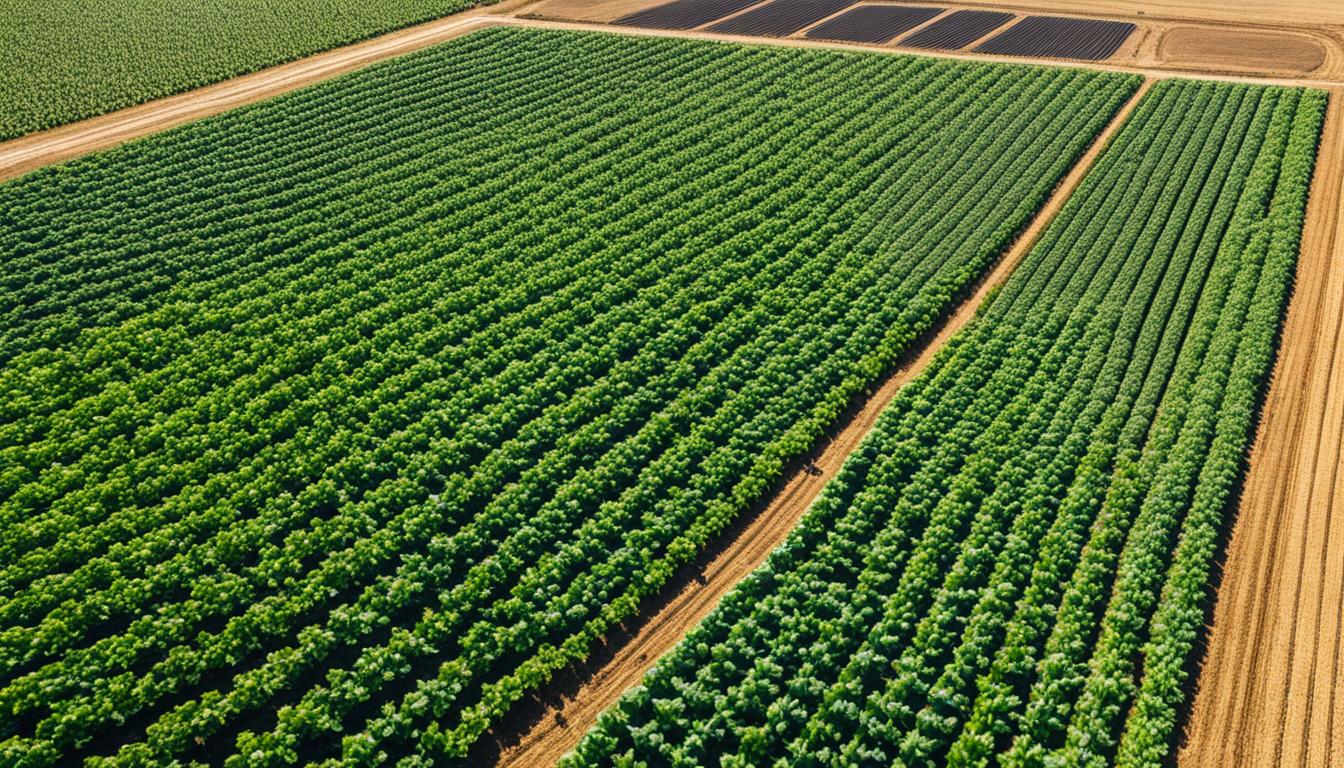
Do you know that sustainable agriculture can boost global crop yields by 20%? It also cuts down on greenhouse gases and saves water. This shows why sustainable farming methods are vital for our future. In this piece, we’ll look at how smart farming helps both the environment and our health. By using eco-friendly methods like crop rotation and not tilling the soil too much, we keep the earth healthy.
This way, the soil keeps its good shape and makes good food for us. Also, by saving our plant and animal friends and letting them help us, farming stays friendly to nature. This friendly farming is key to keeping nature and our health strong.
Sustainable farming tackles big issues like saving the environment and helping future generations. It shows a deep connection between farming and our ecosystem’s health. What we do on our farms affects the health of our lands.
Organic farming doesn’t just help the earth. It improves farm profits and the quality of the food we eat. It cuts costs, which helps farmers make more money. Also, it helps create jobs and makes rural areas better places to live, reducing poverty.
Green farming is about making sure everyone has a fair shot, from farmers to farm workers. This way, food can be grown sustainably without leaving anyone out. It’s good for both the people and the planet for the future.
To connect farming with eco-health, we need methods that are kind to the earth. This includes things like crop rotation, a technique that keeps the soil healthy without using harmful chemicals.
Agroforestry is also key. It means planting trees and crops together to protect the land. All these methods help the environment and make farms more productive.
Choosing organic farming boosts the food we grow and helps farmers get better prices. It proves that sustainable farming is good for the earth and our wallets. This way of farming aims to heal the soil and support plant and animal life.
Normal farming can be very expensive for the planet. An eco-friendlier approach uses less energy and makes less pollution. It also helps more kinds of plants and animals survive.
In the end, farming in a sustainable way is the best choice. It’s good for the environment, our society, and our economy. This is how we can have better farms for the future.
Using sustainable farming boosts the environment, the economy, and helps society. These methods are about more than just making sure we can grow crops. They also keep our natural world and people healthy for the long run.
Sustainable farming helps save natural resources and brings many environmental pluses. It involves techniques like:
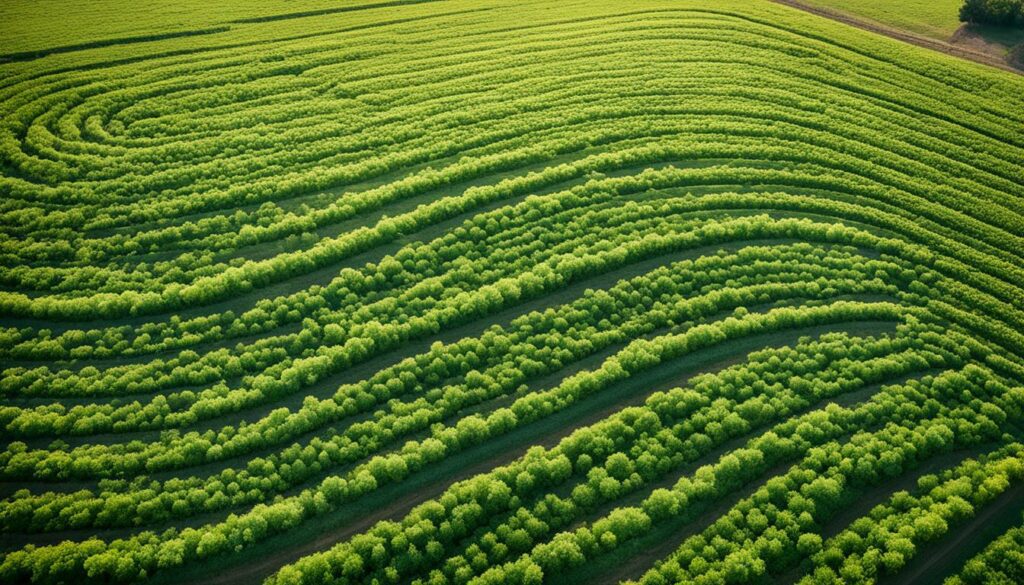
Sustainable farming is not just good for the earth; it can also be good for business. Choosing ethical farming methods can cut costs and boost profits. More farms are also turning to wind and solar power. Here are some financial perks:
Sustainable farming helps make society fairer by aiding rural areas and supporting good work conditions. It spreads the benefits of farming equally among different groups. Here are a few social fairness points:
Using crop rotations and intercropping helps farms stay rich in biodiversity. This means mixing different crops that grow at various times and have different roots. It improves soil and makes the farm’s eco-systems stronger. It’s also a good way to keep pests away without hurting the environment with chemicals.
Intercropping involves planting two or more crops near each other. This comes with many benefits. For example, planting corn and soybeans together can naturally stop pests. Soybeans also add nitrogen to the soil, helping future crops to grow better. This method makes farms more adaptable and eco-friendly.
Different crop rotations, like using alfalfa, pasture, and grains, are great for the soil. By changing the crops, we keep the soil from eroding. Not all plants add the same amount of goodness back to the soil, though. By planning carefully, we can make sure the soil stays rich and healthy.
Adding cover crops to crop rotation also improves the soil. These are crops that cover the soil and their roots keep it strong. It’s important to pick the right ones for each farm. The government should help farmers change to these better farming methods. Crops like rapeseed are good for the land and the economy, so farmers should be able to switch.
Having a lot of different crops around can balance out nature. Bad farming techniques have really hurt the soil over the years. But, by growing different crops one after another, we can make the soil better and fight off pests naturally. This saves us from using harmful chemicals.
Farms with more land can grow many kinds of crops, which is good for their wallets. But farms that are smaller might stick to growing just one type because it’s easier. Trying to use a wider variety of crops makes more food and money. It’s a step towards healthier farms and eco-systems.
Using cover crops is a key step in making soil healthier. During off-seasons, fields get covered. This helps stop soil from being washed away, which can make the land less productive. In 2017, over 15 million acres of land were planted with cover crops. This was a big increase over five years, showing more people are learning about the benefits of this method.
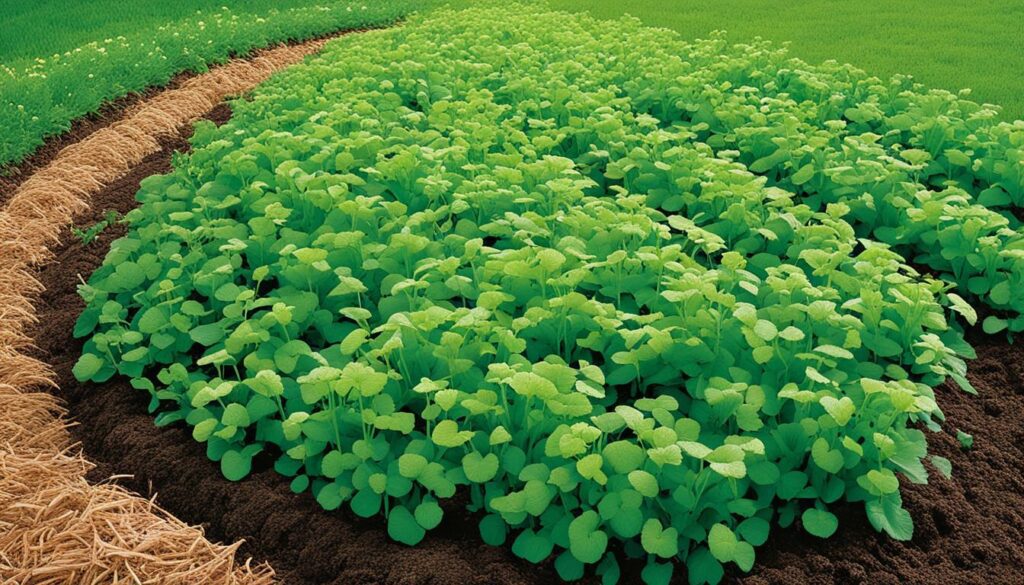
Cover crops do more than just prevent erosion. They also add natural nutrients to the soil. In 2012, a dry year, fields with these crops saw a bigger harvest. Corn grew 9.6% more and soybeans 11.6% more. The reason is, cover crops can add nitrogen back to the soil. This boosts the soil’s health for the next planting season.
By also using no-till farming, fields can soak up more water. This reduces the risk of water pollution and helps fight climate change. From 2012 to 2017, many states saw a huge increase in using cover crops. This method became more popular on farms too, with 15.2% more farms adopting it. So, the idea is really catching on.
To give you an idea of the impact, here are some important numbers:
| Metric | Statistic |
|---|---|
| Increase in cover crop acreage (2012-2017) | 50% |
| Increase in number of farms using cover crops | 15.2% |
| Expected increase in corn yield after 5 years | 3% |
| Expected increase in soybean yield after 5 years | 4.9% |
| Nitrogen fixation by legume cover crops | 50-150 pounds/acre |
| Nitrogen uptake by non-legume cover crops (fall) | 30-50 pounds/acre |
Although starting with cover crops can be costly, the gains over time are usually worth it. They help fight weeds, lower the need for machinery, and promote good bugs and animals. This approach makes farming better for the planet and for the future. Farmers using cover crops and perennials are looking after their soil and environment for the coming years.
Switching to no-till and reduced-till methods is great for saving soil, holding water, and managing soil health. They help keep the ground in good shape for growing food.
No-till farming is about planting without ploughing the land first. It keeps the soil from getting too packed, stops water from running off, and prevents soil from washing away. By 2010, nearly half the crops in California were grown this way. The aim is for even more farmers to use these methods by 2028, which will benefit the soil a lot.
Reduced tillage means not ploughing as often. It aims to keep at least 30% of the ground covered with old plant parts. This reduces the loss of soil, helps keep nutrients in place, and protects the land from the harmful effects of wind and water.
Using these ways also lowers soil erosion by a lot and boosts soil health. They are big helpers in keeping our farms healthy and our crops growing strong.
| Practice | Benefits |
|---|---|
| No-Till | Preserves soil structure, enhances water retention, reduces erosion. |
| Reduced-Till | Decreases tillage passes by 40%+, maintains 30% soil residue cover, improves soil health by 30%. |
Integrated Pest Management (IPM) uses ways to control pests without just chemicals. It focuses on keeping nature balanced. By using both natural and mechanical methods, farmers can use fewer harmful chemicals. This is better for the environment.

Using traps, barriers, and removing pests by hand is vital in dealing with pests sustainably. These ways limit harm to the environment. They help control pests without adding dangerous chemicals to nature.
Biological methods work with nature to control pests. This uses good insects like ladybirds to eat bad bugs. It’s a way to keep ecosystems healthy without chemicals. This helps good bugs and lessens pollution.
Since the 1990s, the UC Statewide IPM Program has guided farmers on pest control for over 65 crops. They use various methods without depending too much on pesticides. Their aim is to control pests in smarter ways, harming less of the environment.
The UC IPM works with various groups to share the latest in pest management knowledge. This team effort offers help and advice to farmers. It’s designed to aid them in choosing the best pest control methods for their farms. This way, they encourage pest control that’s good for the earth.
Bringing together livestock and crops on a farm has many benefits. It improves farming through the interaction of animals with plants. This approach makes use of resources in a smarter way, helping farms to be greener.It also boosts the farm’s ability to stay sustainable. This is crucial for agriculture today.
In the US, keeping livestock and crops separate can cost more. This is because organic grains can be expensive. Plus, moving these goods around creates more greenhouse gases.
Joining crops and animals on a farm can cut costs and earn more. A USDA project found this.
Livestock also helps build healthy soil. Their manure stores carbon, which is good for the environment. They also help lower pest numbers. For instance, people prefer beef from steers that eat winter wheat over those on winter rye. Mixed-breed cows also have better fats in their meat than pure Holsteins.
Some good crop rotations include having the field in use at least part of the year. For example, having dairy steers eat winter rye or wheat. This keeps both the land and the animals in good shape.
| Crop Rotation | Components | Livestock Utilisation |
|---|---|---|
| Pasture-winter wheat-soybean-pasture | Wheat, Soybean, Pasture | Grazing dairy steers on cover crops |
| Pasture-winter rye/hairy vetch-corn-pasture | Rye, Hairy Vetch, Corn, Pasture | Grazing dairy steers on cover crops |
This mix of livestock and crops benefits the land. It makes the soil hold more water. The ground becomes more full of life and works better. This means fewer pests and weeds.
Grazing animals on fields with fruit trees also keeps pests away. This helps make more money from the land. It also makes the ground healthier. This is good for the farm’s economy.
To sum up, linking animals and plants on a farm makes everything work better. It’s good for the earth and the farm’s future. People like it, and it’s good for making agriculture last. It’s a smart way to farm for the long haul.
Agroforestry is key to making farming more sustainable. It combines trees with crops and animals, creating a rich mix. This mix helps protect nature and boost diversity. These ways of farming have been influenced by ancient Native Americans and early Europeans. They have grown into the methods we use today.
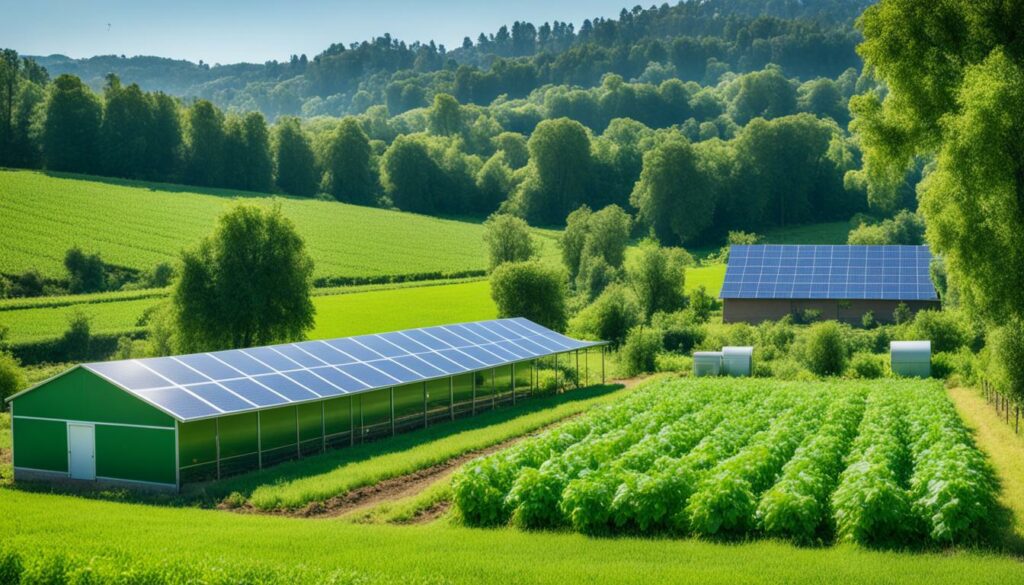
Agroforestry boosts life and enhances the land in big ways. Adding trees to farms gives more homes to wildlife and improves the soil. It also solves food worries and makes our air and water cleaner. The USDA works towards these goals, showing how vital agroforestry is for our planet.
Agroforestry isn’t just good for the planet; it’s smart business. The USDA helps farmers with support and info, aiding in job growth in farming areas. With more study and applying agroforestry widely, farming for profit is possible through selling fruits, nuts, and bioenergy. This links earning money with caring for the earth.
The USDA plays a big part in spreading agroforestry. It works with many groups to make these farming methods known all over – in warm and cool places. This mix of farming and nature care strengthens the economy and notes the vital role of nature.
Looking into sustainable farming shows us that only focusing on separate fields isn’t enough. We need to look at the big picture. By using techniques like regenerative farming, we can improve biodiversity support. We also keep the soil and the ecosystems around it healthy.
Farms that change crops and welcome variety notice better soil and less pests. Adding cover crops and plants that live for many years cut down soil loss and add nutrients. This also means farms don’t need as many chemical fertilisers and weed killers. Using less or no ploughing is also key, reducing soil loss and making the soil healthier overall.
Taking an all-round view is key. Using strategies that handle pests without lots of chemicals means less harm to pests and more profit. Mixing livestock with crops makes farms work 10% better and be 15% more profitable. This connection shows how thinking about the whole picture helps in farming sustainably.
Agroforestry, combining farming with trees, is good for the environment and the farm’s wallet. It uses less water, attracts more life, and can sell fruits or nuts for extra income. By managing farms this way, we stop nutrients leaking away by 30% and soil from being washed off by 20%. Farmers also see a 15% growth in local pollinators, showing how sustainable farming is good for everything.
These findings highlight the clear benefits of looking at entire farms. Farms focusing on the whole ecosystem ensure their future and the health of their surroundings. It’s about sustaining both the farm’s environment and the larger world around it.
Improving natural assets on farms is vital for lasting farming. This includes enhancing farm dams, shelterbelts, and paddock trees. Doing this ensures better water quality, wildlife homes, and sustained care for the land over time.
Farm dams are key in making farm water cleaner. They collect water and help with water flow, cutting soil erosion caused by farming. Well-looked after farm dams boost soil’s ability to hold water. This helps in keeping the water clean for the whole area. Less use of artificial chemicals keeps these water sources healthy.
Shelterbelts are rows of trees or bushes that guard against the wind and prevent water loss. They make the land better and provide homes for wildlife. They need less chemical help, making them good for organic farming. Shelterbelts also add to the variety of life on the farm, helping create a balanced environment.
Bringing back paddock trees helps the land heal naturally. These trees give animals shade and improve their living conditions. They also keep the soil healthy and offer homes to local plants and animals, lifting the farm’s natural care. What’s more, they fight climate change by storing carbon.
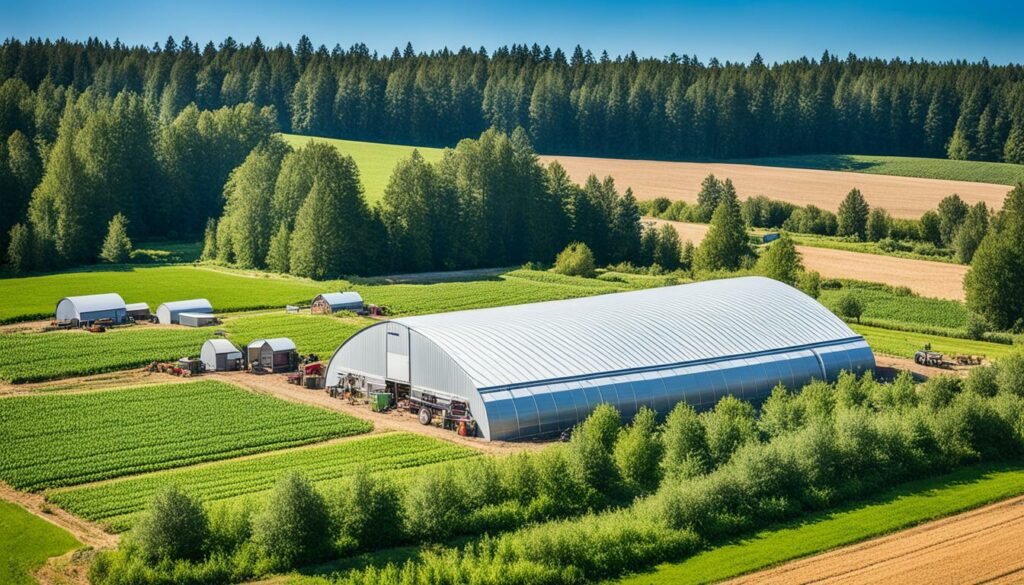
| Natural Asset | Primary Benefit | Long-Term Impact |
|---|---|---|
| Farm Dams | Improved Water Quality | Enhanced water-holding capacity, reduced erosion |
| Shelterbelts | Protection Against Erosion | Boosted biodiversity, increased wildlife habitats |
| Paddock Trees | Shade and Shelter for Livestock | Better soil health, carbon sequestration, ecosystem restoration |
Sustainable farming in the real world often shows theories put into action. It’s clear through these cases how eco-farming greatly improves our land. The practices lead to a stronger and more fruitful environment for growing food.
John and Nicole at Allawah use no-till farming to keep their land healthy. This method helps their soil keep more water and stops it from eroding. They’ve seen their crops grow by 20%. They also avoid using a lot of pesticides by managing pests in smart ways. This keeps their land and food ecosystem healthy.
Paul and Rachel in Bongongo change the types of crops they grow. This helps manage pests without using a lot of chemicals. Their soil gets better because of this. They also grow trees, which protect the soil and help the water stay. This makes their plants and animals grow better.
Sam and Claire run a great farm at Windermere by mixing farming with herding. This way of farming uses resources well, leading to more food and better nature. They also take special care of water, making sure they use it well. This is important for keeping the land healthy.
The improved crops and health show us how important sustainable farming is. It proves that eco-farming works well for the land and the people. These good examples are key for others to follow. This way, we can keep making farming better for the future.
Sustainable farming is key for meeting food demands and fighting environmental issues. Soil depletion and water shortage are big obstacles. These problems affect how much we can grow and harm the land. We must use better ways to restore the soil and save water.
About 33% of farming land worldwide is losing its ability to grow. This makes our soil less productive and more at risk. We need to fix this by using methods like planting cover crops and not tilling the land. Such approaches improve the soil, help store carbon, and make our ecosystems stronger. Using these methods, we can keep our soil healthy for growing food for the future.
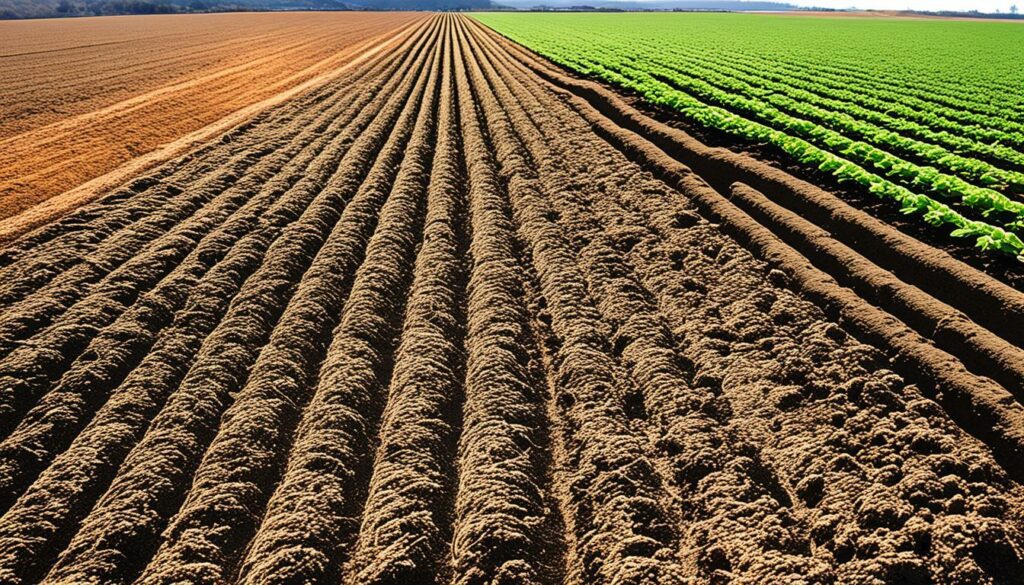
Farming uses up a lot of the world’s freshwater – around 70%. So, it’s vital we learn to use water wisely. Technologies like smart irrigation, along with reducing water runoff, are important. We should also take care of how water moves across the land. By doing this, we can use less water and keep it clean and ready for growing crops.
| Challenge | Solution |
|---|---|
| Soil Depletion | Cover cropping, no-till farming, composting |
| Water Scarcity | Efficient irrigation, runoff reduction, landscape-level water management |
About 90% of the world’s farmers are small-scale. They often find it hard to get the support they need for new farming methods. They need help with learning about and using these better ways of farming. This is where education, training, and help from the government come in. By supporting these farmers, we can make farming better for everyone. This leads to more food and happier farming communities all over the world.
Looking back at how sustainable farming has evolved, we see a journey shaped by new tech, government rules, and fresh farming ideas. Since World War II, the growth of sustainable farming has been remarkable. The future of farming relies on taking care of the environment, making profits, and being fair to everyone. We must keep changing and improving our ways to meet the needs of today without harming the chances of those who come after us.
The key to lasting success in farming lies in building resilient and varied farm systems. It’s vital to use a mix of methods that involve research, teaching, and everyone interested in farming. Today, agricultural research is more advanced, thanks to teams of experts from many fields. Entities like SARE help by sharing useful information and advice. Working together across different areas of expertise not only boosts how well we farm but also how we work together as a team.
Indeed, the real win in sustainable farming will come from working together towards keeping our planet healthy. By sticking to sustainable ways and always improving them, we can keep our farms strong and able. This means always learning from new research, teaming up with others, and wisely using our resources. Our success in the future is all about the promises we make today, making sure we look after our natural resources and strengthen the wellbeing of our farming communities.
Sustainable farming aims to have minimal impact on the environment and save resources. Methods include crop rotation, intercropping, and not using harsh chemicals. They help make farming kinder to our planet.
It improves soil by planting cover crops that stop soil erosion and add nutrients. No-dig farming keeps the soil’s health. This way, there’s less need for chemicals and the soil stays rich.
Sustainable farming is better for the environment. It uses less fuel and water, and helps soil and nature to renew. This kind of farming supports a healthy planet for everyone.
Making good money in sustainable farming means keeping costs low. This way, farmers can support their local area and treat everyone fairly. Using land for both crops and animals brings in extra money.
Sprucing up crop variety helps keep pests away. By mixing plants, pests don’t find a regular food source. This means less need for harmful sprays.
Cover crops and perennials are the quiet heroes of sustainable farming. They stop soil from washing away and feed it with what it needs naturally. This saves money on chemicals and supports life in the soil.
Not tilling the soil much keeps it from losing nutrients and water. It also saves fuel, which is good for the planet. These gentle farming methods help our world for the long run.
IPM mixes different ways to fight off pests without chemicals. This prevents harm to good bugs and the environment. It’s a smart green way to keep the bugs in check.
Farming animals and crops together makes everything work better. It needs less new stuff and feeds the soil. This is how farming should be – everything helping everything else.
Agroforestry mixes trees into farms, which is great for nature and our wallets. It gives animals a home, helps crops grow, and may even make some money. This is farming and nature working hand in hand.
To take good care of the land, we must protect the natural areas and support all kinds of life. This is key to farming well for a long time without damaging the earth.
Making nature strong on farms protects water, shelters wildlife, and stops soil from wearing away. This makes farms better places for all who live there, including us.
Sure, for example, the Hopkins at Allawah and the Grahams at Bongongo have shown how to farm in harmony with nature. The Johnsons at Windermere also do great work. Their success helps their farms and the community.
It can be tough to keep soil and water healthy. But by using smart farming techniques, these challenges can be overcome. This is how we look after the land for the future.